Does anyone still make mid-sized family sedans? Haven’t they all been cancelled – in favor of crossovers?
Most of them, yes. Including – most recently – the Mazda6 sedan, which Mazda announced it won’t be selling anymore after the end of this model year.
But there are still a few.
One of the remaining not-quite-last-of-the-Mohicans being the 2022 Hyundai Sonata – which survives in part because it is roomy enough to accommodate a family and their stuff – in its roomy 16 cubic foot trunk, which is as large as some full-sized cars’ trunks.
It also has the most legroom – up front – and by far – that you’ll find in anything same-sized, including same-sized crossovers. An astounding 46.1 inches of it.
For some sense of that, a full-sized/six-figure luxury sedan like the current BMW 7 Series only has 41.4 inches of legroom up front.
It’s also available without a tiny turbocharged engine. Or have one, if that is your preference. The Sonata offers the choice of either – as well as one in the middle.
Plus another that splits the difference.
What It Is
The Sonata is Hyundai’s mid-sized family sedan. It competes with the handful of still-available similar sedans made by Toyota (Camry), Honda (Accord) and Nissan (Altima) as well as its Kia-badged cousin, the K5 – reviewed here – which isn’t just a reskinned and rebadged Sonata (or the reverse). The K5 comes standard with the 1.6 liter turbocharged engine that’s optional in the Sonata – and it is available with AWD, while all Sonata trims are front-wheel-drive.
Prices start at $24,150 for the base SE trim, which comes with a larger (than the Kia’s standard) 2.5 liter engine, without a turbo – paired with an eight-speed automatic transmission. The SEL Plus trim gets a 1.6 liter turbocharged engine, plus upgraded amenities such as a 12 speaker Bose premium audio system, simulated leather seating and a 19-inch wheel/tire package.
The top-of-the-line N-Line gets a turbocharged version of the 2.5 liter engine that musters 290 horsepower (the same as the same engine in the top-of-the-line Kia K5 GT) paired with a quicker-shifting eight speed dual clutch automatic, more aggressively tuned suspension, sport wheel/tire package and N-Line cosmetic upgrades.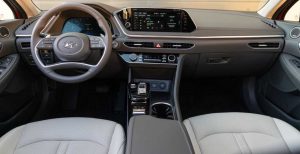
This one stickers for $34,750.
The Sonata’s Kia cousin starts at $23,460 for the base LX with the 1.6 liter turbo and tops out at $31,090 for the GT.
There is also a hybrid version of the Sonata. It stickers for $27,750 to start.
A plug-in version is reportedly coming.
What’s New
The N Line is available with a Night Edition appearance package; this includes unique trim, specific wheels, a rear spoiler and special badging.
SEL trims now include the options bundled under the previously optional Tech Package as part of their roster of standard equipment. In addition to tech – an enhanced Adaptive Cruise Control System and Lane Keep Assist – this includes amenities such as a panorama glass sunroof and a 12 speaker Bose premium audio system.
What’s Good
So much front seat legroom a 6ft 3 man can barely reach the pedals with the seat all the way back. Lay the seat back and it’s a fine place to take a nap.
Three engines to pick from. Four, if you count the hybrid.
Full-size trunk, mid-sized car.
What’s Not So Good
Kia cousin costs less, is available with AWD.
No V6 engine.
Big trunk is still a small space relative to the room for stuff available in a same-sized crossover.
One of the things the Sonata offers that none of its rivals do is more than just a standard and an optional engine, as in the Toyota Camry, the Honda Accord, Nissan Altima and even its Kia-badged cousin, the K5 sedan.
They offer two. The Sonata, three – plus the hybrid option.
These options give you choices – and not just in terms of power and gas mileage.
The first option is to skip a turbocharged engine, which you can’t if you were to buy the Sonata’s Kia-badged cousin, which comes standard with one (and which offers another one as its optional engine).
There are sound, practical reasons to not want a turbocharged engine, including the built-in greater complexity of the turbocharged engine, which automatically increases the odds of something turbo-related eventually needing to be fixed. For the buyer who wants to reduce his odds of ever having to spend money on turbo-related fixes, a not-turbocharged engine is the better bet – especially if said buyer is the type who intends to keep the same car for 12-15 years or more and perhaps wants to hand it off to a son or daughter at the end of that time – without needing to spend money on a new turbo or peripherals around that time.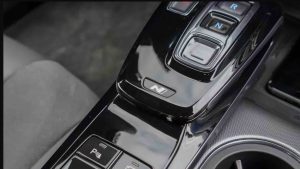
For such a buyer, Hyundai offers the Sonata with a 2.5 liter four that’s large enough to not need a turbo to make adequate power – 190 horsepower. This engine – which is paired with an eight speed automatic (not a CVT automatic) also delivers excellent fuel economy, 28 MPG in city driving and 38 on the highway. And it will never need a new turbo – because it hasn’t got one.
For the buyer who wants a turbo – and the low-end boost you get when you turbocharge an engine – the Sonata is also available with a 1.6 liter four that makes up for its small size with . . . a turbocharger. It boost the horsepower to 180 – a bit less than the 2.5 liter engine makes – but increases the torque output to 195 ft.-lbs. (from the 2.5’s 181 ft.-lbs.) and makes it almost immediately, at 1,500 RPM (vs. 4,000 for the non-turbo’d 2.5 liter four). This results in more authoritative – and easier-feeling – acceleration from a dead stop and with less pressure on the gas pedal.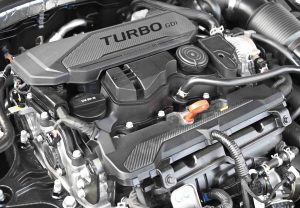
However, this engine doesn’t use less gas. In fact it uses slightly more. EPA rates the 1.6 liter-equipped Sonata’s mileage at 27 city, 37 highway. The good news is you do not have to feed this boosted engine premium fuel – as is often the case with turbocharged engines.
For more boost – and power – there is the turbocharged version of the 2.5 liter engine that comes in the N-Line. It combines the displacement advantage of the 2.5 liter engine with the horsepower (and torque) enhancement of a turbo, to make 290 hp and 311 ft.-lbs. of torque, the latter figure being within about 40 ft.-lbs. of the torque made by a V8 without a turbo.
Equipped with this engine, the Sonata’s mileage dips to 23 city, 33 highway – but so does the 0-60 time, which goes down to just over 5 seconds, a speedy time for the class. Equipped with the 1.6 liter engine, it takes a Sonata about 7.8 seconds to make the same run and just over 8 with the base 2.5 liter engine.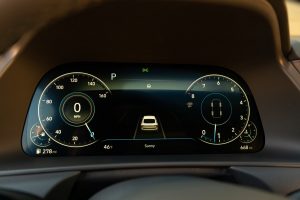
For maximum mileage, Hyundai also offers a hybrid version of the Sonata that can go 51 miles (on the highway) on a gallon of gas (45 miles in city driving). This one does not, of course, get to 60 in just over 5 seconds, though. The price you pay to use less gas is not going as fast. The hybrid Sonata needs about 7.8 seconds to reach 60 – which is still about the same as the Sonata equipped with the 1.6 liter engine – while using much less gas to do so.
One choice you haven’t got with this Hyundai is front-wheel-drive or all-wheel-drive, the latter being an option that is offered with the Sonata’s cousin, the K5 – as well as the Toyota Camry, which is also the only mid-sized, family-priced sedan you can still buy new that’s still available with a V6 engine.
On The Road
Not being so high up can be appealing, too.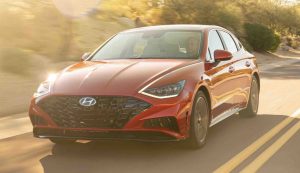
Crossovers are popular, in part, because many people like not being low to the ground. More accurately, they prefer not being surrounded by crossovers and SUVs that are so high off the ground – because it is so hard to see past or around them. This of course creates a feedback loop. The more people buy crossovers, in order to be able to past and around them, the more crossovers there are on the road and the harder it becomes to see past or around them, if you’re not driving a crossover or SUV, too.
But there are downsides to driving a crossover – and to being so high off the ground, relative to a car. The cost of that up-high ride height and increased ground clearance being often-clumsy/top-heavy handling in the curves and at high speed. It is like trying to make an Airbus perform acrobatics.
A car like this Sonata – which sits just 5.3 inches off the ground – is inherently more stable than a crossover or SUV that’s riding several inches higher off the ground – and which for that reason has more air flowing underneath it and which also presents a less aerodynamic profile. There is also the issue of the crossover/SUV’s weight sloshing around more readily, being up higher rather than lower to the ground.
There is also the homogeneity – the bleakness of sameness. When you drive something other than a crossover or SUV, you are driving something else.
These are generic car (sedan) virtues relative to crossovers/SUVs.
Sonata-specific virtues include lower door top height and lots of glass height, which helps you see more when surrounded by those crossovers and SUVs – and see more of the outside world when you aren’t surrounded by them.
Hyundai didn’t go the easy/cheap route for passing muster with federal door/side-impact standards – by raising up the height of the doors. Instead, the structure is built into the doors, allowing for door tops low enough to rest your elbow on top with the window rolled down – something that once contributed greatly to the pleasure of the drive. And now does, again.
Multiple engines – with different personalities – is another Sonata-specific virtue. The base 2.5 engine is for the driver who doesn’t mind digging a little deeper to summon its power, of which there is plenty. 190 horsepower was V8 Z28 Camaro horsepower back in the ’80s and this car is just as quick to 60. But you do have to push down on the gas pedal – and harder – to get that power.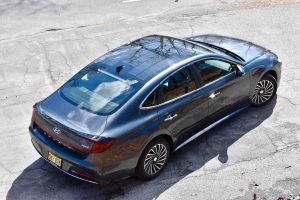
The 1.6 turbo engine is the more relaxed engine. These small, turbocharged gas engines do a fair job of emulating diesel engines, in terms of making a lot of low-RPM torque – which provides immediate, low-RPM thrust. With this engine, one hardly ever needs to swing the tachometer needle past 3,500 RPM. It will accelerate the Sonata just as well as the 2.5 engine but with much less apparent effort and that is its chief virtue. This engine is probably the best choice for the suburban/urban commute and the stop-and-go-driving that typifies it.
The N-Line’s turbocharged engines combines the easygoing low-end characteristics of the 1.6 engine with the high-RPM power of a larger V6 engine, as available in the Camry – which makes plenty of horsepower but not as much torque (311 ft. lbs. for the Sonata’s four at 1,650 RPM vs. 267 ft.-lbs at 4,400 RPM for the Toyota).
This is its chief virtue.
At The Curb
It’s become as hard to impart style to a sedan as to a crossover or SUV – not for lack of imagination but because of government regulations. One-size-fits-all (the same standards for all) tends to mean the same appearance, for all. But Hyundai achieves visual separation in the details, such as the lower door tops – and the interesting thin-line chrome strips that run along the tops of each front fender, where they blend into the headlights.
The Sonata’s standout feature, however, isn’t its appearance. It is its roominess. This mid-sized sedan has the roomiest front seats you’ll find in anything, car or crossover – that isn’t a Kia.
I had to double check the specs – 46.1 inches of front seat legroom – and then try it out, myself. And what I found is that a 6ft. 3 man (me) can just barely toe-touch the pedals with the driver’s seat extended all the way back.
The front seat passenger, of course, has similar room – and it means he or she can lay that seat back and experience an almost-bed for the duration of the trip. The range of the front seats is also such that the room for the back seat occupants can be greatly increased without cramping the people up front. The overall effect is general spaciousness, a fact that is enhanced by the feel you get from all that glass that surrounds you – and from being able to rest your elbow, if you like, on the top of the door with the windows rolled down.
The trunk is also large – for a car. The Sonata’s 16 cubic-footer is larger than the Camry’s 15.1 cubic footer – though not quite as large as the current Honda Accord’s class-leading 16.7 cubic footer. And the Accord has about four inches less legroom up front (42.3 inches) as well as offering only two engines.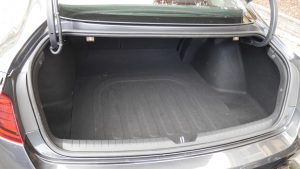
The problem – for all of them – is that even 16 cubic feet is small, relative to the space inside a smaller crossover, which will usually have at least 30-something cubic feet of cargo space available. This makes the crossover much more practical and hence its appeal as a family-hauler, the duty mid-sized sedans once fulfilled but not longer do. It is why mid-sized sedans like the Sonata and Camry and Accord have become more stylish than they used to be.
Because they have to be.
Which brings up the Sonata’s available (on SEL and higher trims) all-LCD dash and secondary cluster, a feature that as recently as four or so years ago was only available in very high-end cars. Now you can toggle through multiple driver-selectable gauge clusters, changing according to the drive mode you’re in – Sport, Eco, Comfort, etc. And you can dial up the sounds – and sights – of being in a cool rainforest or a cozy cafe, ease your nerves after a difficult day at work.
The Rest
Hyundai has been careful not to compete too much against itself- through its Kia subsidiary. This being the mistake GM made, by trying to sell the same basic car through several different divisions. Hyundai avoids that mistake by selling related – but still significantly different – cars through its two divisions. The Hyundai Sonata is kin to the Kia K5 but each offers different mechanicals as well as a different appearance and a different price structure. This makes sense in the way that it once made sense when Pontiac sold Firebirds that were related to Chevy Camaros but not the same as Camaros excepting a few superficial cosmetic differences.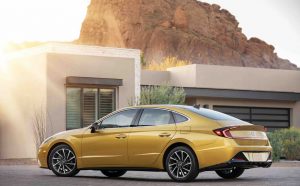
The Sonata – like the Firebird (RIP) will appeal to certain people while the K5 (like the Camaro) will appeal to others, for different reasons.
The Bottom Line
Whether Hyundai – or Kia – it’s nice to see these cars still hanging around!
. . .
Got a question about cars, Libertarian politics – or anything else? Click on the “ask Eric” link and send ’em in! Or email me at EPeters952@yahoo.com if the @!** “ask Eric” button doesn’t work!
If you like what you’ve found here please consider supporting EPautos.
We depend on you to keep the wheels turning!
Our donate button is here.
If you prefer not to use PayPal, our mailing address is:
EPautos
721 Hummingbird Lane SE
Copper Hill, VA 24079
PS: Get an EPautos magnet or sticker or coaster in return for a $20 or more one-time donation or a $10 or more monthly recurring donation. (Please be sure to tell us you want a magnet or sticker or coaster – and also, provide an address, so we know where to mail the thing!)
My eBook about car buying (new and used) is also available for your favorite price – free! Click here. If that fails, email me at EPeters952@yahoo.com and I will send you a copy directly!


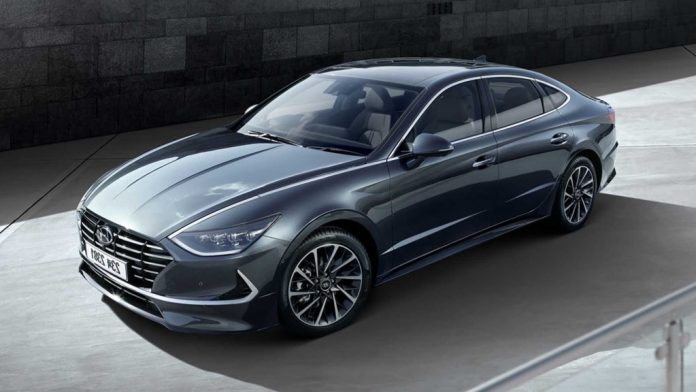


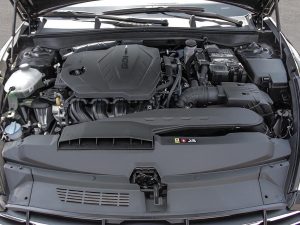
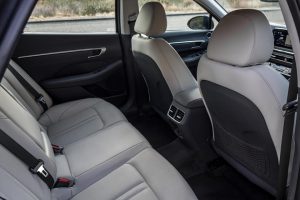








My thanks to the imports for giving us choices.